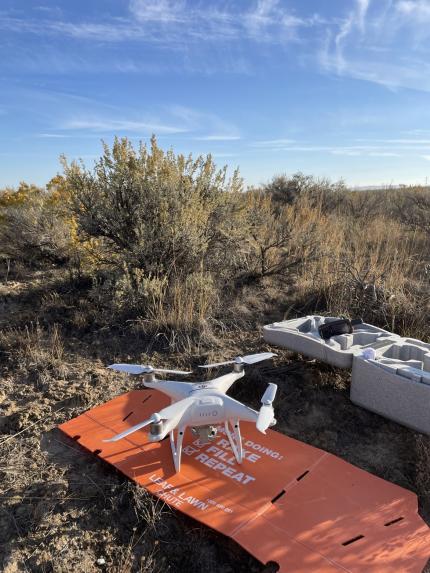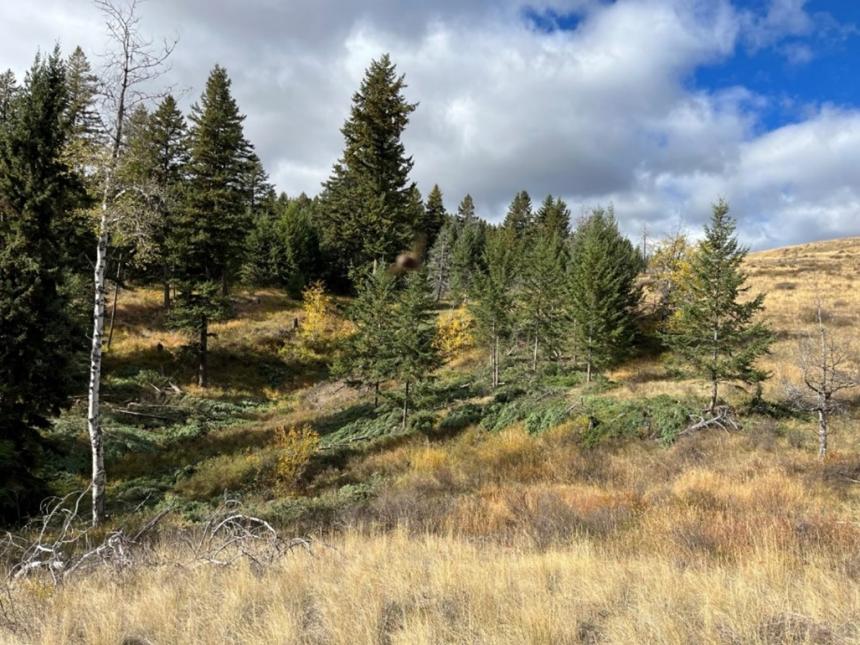Managing Wildlife Populations
Mule Deer Studies: Biologists Jeffreys and Eilers teamed up with Ungulate Specialist Bundick to place 15 remote cameras on game trails in and around Blewett Pass. These cameras will be used to capture images of mule deer from the Wenatchee Mountains herd undertaking their annual eastward migration to their lower elevation winter range.
Biologists will analyze all images collected to determine age and sex of photographed deer. They will use this information to generate fawn to doe and buck to doe ratios for the herd. Biologists will compare these ratios with those obtained from aerial surveys, which are set to take place in early December. This will help determine whether remote camera placement is a viable method to assess mule deer herd composition moving forward.

To identify the best locations for camera placement, Washington State Department of Fish and Wildlife staff members analyzed GPS data collected from does, which were collared on their winter range in the Wenatchee Foothills in 2020 and 2022. With three years of fall migration data now available biologists were able to determine, which areas along Highway 97 were used most consistently by the collared does each fall.
Additionally, Biologists Eilers and Jeffreys and Ungulate Specialist Bundick went out into the field. Parking along stretches of Highway 97, they visually searched for deer trails crossing the highway. They sought well-established, intersecting pathways through the trees and underbrush as locations where cameras were most likely to capture the greatest number of images of deer groups. Once a promising site was identified, they secured a game camera in a tree facing the trail. These cameras will be retrieved, and the photos will be analyzed in the winter after fall migration has ended.

Fisher Monitoring: Wildlife Conflict Specialist Bridges and Biologists Eilers, Jeffreys, and Soltysiak teamed up to begin deploying baited camera stations for fisher monitoring in forested areas throughout Chelan County. Images collected at these baited camera traps will be used to help evaluate the effectiveness of the reintroduction of fishers back into the Cascades fisher recovery area. They will also inform future recovery actions by assessing the expansion and distribution of fishers. The idea is to draw any fishers inhabiting the vicinity into view of the game camera by placing a dispenser loaded with extremely potent skunk scent over a cow bone on a tree approximately 15 feet to 18 feet away from and in full view of the camera.
This scent lure dispenser will drip the pungent liquid on a beef bone at predetermined intervals throughout the winter. Their goal is to attract any nearby carnivores. In addition to fisher, the baited camera stations are likely to capture images of other carnivore species of concern, including gray wolf, wolverine, and lynx.
To further assess fisher occupancy and expansion, a hair snare belt is nailed to the tree right below the beef bone with the aim of snagging hairs from visiting animals climbing the tree that can then be used for DNA analysis. All data generated from these baited camera stations will be instrumental in learning more about the distribution of fishers and other carnivore species throughout the Cascade Range.
Biologists from collaborating agencies and organizations such as U.S. Forest Service and Conservation Northwest have already placed several cameras in Chelan County. District 7 staff members have now placed one in Tumwater Canyon, one off Ruby Creek Road, and one in the Grouse Mountain area. In total, District 7 Washington State Department of Fish and Wildlife staff members will deploy 20 baited camera stations before Nov. 1. These camera stations will be retrieved, and images analyzed in the spring and summer of 2024.

Pygmy Rabbit Enclosure Captures: At the end of each summer, the pygmy rabbit recovery team visits each breeding enclosure to ensure that there aren’t any remaining kits. Additionally, they vaccinate adults against rabbit hemorrhagic disease (RHD). Over the summer some kits were captured, but they were too small to receive a PIT tag, RHDV2 vaccine, and DNA sample. On Oct. 2, the team was joined by Washington State Department of Fish and Wildlife volunteers and Washington State University students to capture these kits. The team was successful in trapping two rabbits, both male, who appeared strong and healthy. Unfortunately, they also found a mortality. They identified it later as B4E102, a young female who was likely predated by a raptor.
On Oct. 3, the team turned their efforts to the B4 Beezley Hills enclosure. It was confirmed that all kits had been removed from the enclosure. Happily, four adults were caught and then vaccinated for RHD. One of the rabbits, adult B3E119, gave the team the slip until this capture effort. Knowing which adults are present helps Geneticist Dr. Nerkowski trace rabbit lineages.
Biologist Soltysiak set game cameras inside the B3 enclosure, along with enticing apples, to ascertain how many rabbits are inside of B3. It appears that just one rabbit now resides in the B3 enclosure. Previously, two rabbits were known to reside there.


Drone Flights: Biologist Soltysiak and Data Manager Jansen flew drones over the Sagebrush Flats Wildlife Area. They tested what height drones should be flown to get the best picture of pygmy rabbit burrows from the air. An area with a high density of burrows was chosen as the test area. Drones were flown at 150, 200, 300, and 375 feet.
Flying at a lower altitude gives better picture clarity but it takes a longer amount of time. Drone batteries only last around 30 minutes. Flying the drone at a higher altitude covers more area in a shorter amount of time. The team is hoping to find the sweet spot where burrows are still easily seen in the imagery while maximizing the amount of area flown in a single session.

Department of Natural Resources Collaborations: A few weeks ago, the Methow Wildlife Area hosted a tour with about ten Department of Natural Resources (DNR) employees to look at some future collaborative projects. For example, the Methow Wildlife Area plans to conduct forest thinning and prescribed burning treatments at various locations. Our projects neighbor quite a few private property parcels and some of the neighbors have expressed interest in simultaneously treating their forests.
DNR brought a diverse group of staff members to look at the feasibility of collaborating with Washington Department of Fish and Wildlife (WDFW) and the private property owners. This cross-agency collaboration is still in the early phases of development, but both DNR and WDFW are committed to helping our neighbors maintain healthy and resilient forests in the Methow Valley.
Hazard Trees: General deer season kicks off this weekend. It is one of our busiest times of the year and our campgrounds and primitive camping areas receive very high visitor use. To ensure our visitors have a safe and enjoyable hunting season, Methow Wildlife Area staff members have been diligent about assessing and removing hazardous trees from popular camping areas. Several dead snags have been mitigated at Bobcat, Beaver Creek, Cougar Lake, and Bear Creek campgrounds.
Washington Conservation Crew: Recently, a Washington Conservation Crew (WCC) spent a week performing some much-needed fence maintenance. This fence project is intended to keep neighboring cattle from entering the wildlife area and engaging in unauthorized grazing in the post fire recovery Cub Creek 2 burn scar area. The crew will be back in early November. Weather permitting, they hope to build a wildlife friendly buck and rail fence along a small section of Beaver Creek.
This fence borders a campground and is intended to protect endangered fish by keeping livestock out of the creek while still allowing safe passage for a wide array of wildlife. Buck and rail fences are the preferred fence in campgrounds since they are built completely out of wood and are safer for children and families camping in the area. They are also more aesthetically pleasing than wire fencing.
Big Buck Fencing: The Methow Wildlife Area has received numerous reports about unauthorized cattle in the Big Buck Unit. The cows have trickled over from a neighboring private property grazing allotment and broke down a sizable stretch of fencing around Deadhorse Lake. The livestock owner was contacted and is working diligently to find and round up all of the cattle. Additionally, Methow Wildlife Area staff members spent the better part of a day repairing the riparian exclusion fencing to try and keep cattle out of the lake.

Providing Recreation Opportunities
National Hunting and Fishing Day: A few weeks ago, Methow Wildlife Area Manager Troyer ventured over to Region 1 in eastern Washington to help at the National Hunting and Fishing Day event. This event was held at Diamond Lake near Newport.
The event was very well attended with several hundred youth taking part in the festivities. There were tons of activities for kids and families to choose from. The activities included an archery range, air rifle range, and trout fishing. Troyer got to work with various volunteers and Region 1 staff members at a very busy fishing dock where hundreds of trout were stocked in net pens for the kids to catch.
From the time the event started at 9 a.m. until it ended at 3 p.m. the dock was full of kids catching fish. Countless hooks were baited, and tons of fish were caught. For many kids, this was the first time they ever fished. Luckily, the fish were biting. Every child that wanted to catch a fish was successful.
There was also a fish cleaning station so the kids could take their catch home with them. If they didn’t want to take their fish home, it was donated to a local foodbank. Overall, it was an excellent event coordinated by our Region 1 colleagues. It was an excellent way to get kids involved in hunting and fishing.

Conserving Natural Landscapes
Scotch Creek Riparian Restoration Project: Staff members wove four new beaver dam analogs with weave material collected off the Chopaka Unit and planted 100 water birch within the enclosure that was constructed the previous week. Water birch is an important food source for sharp-tail grouse in the winter when snow depths prohibit them from accessing the vegetation.


Proposed Winter Range Closure: The Methow Wildlife Area is still conducting outreach, fielding a wide range of phone calls and emails, and collecting survey input related to the proposed winter range closure.
The survey is open until Oct. 15. To learn more about the proposed closure to protect mule deer, please view the News Release. Towards the top of the news release is a yellow box that contains some useful documents such as maps and a fact sheet. Please feel free to contact us if you want to learn more. Your input is valuable and appreciated.